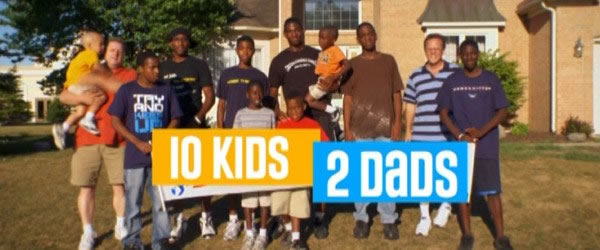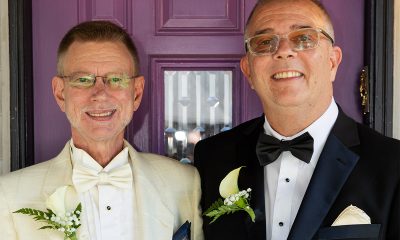Living
10 kids, 2 dads
Gay couple takes Father’s Day to a whole new level


Clint McCormack and Bryan Reamer are raising 10 kids in Michigan. (Photo courtesy the couple)
Trying to do a phone interview with Clint McCormack and Bryan Reamer, the two parents who were featured in OWN’s “10 Kids, 2 Dads” reality special last year, is a lot like trying to get honey out of a bee-lined hive. You’re not going to have an easy time of it. One kid comes in asking about food, another interrupts to talk about schoolwork, a third has just awoken from a nap and wants attention.
Still, somehow, the dads manage to live in this sort of controlled chaotic environment and create a loving family atmosphere where everyone is happy.
As a committed gay couple living in suburban Michigan, the couple knew they wanted to start a family, but 10 kids and nonstop commotion wasn’t exactly what they had envisioned.
What might seem crazy to most just felt right to the Farmington Hills couple, that originally set out to adopt just one child before eventually winding up with their 10 boys. McCormack comes from a family of six children while Reamer has just a brother, but both wanted to raise a family.
“We never intentionally wanted to adopt 10 children; it was the furthest thing from our minds,” McCormack says. “We thought maybe two or three max, but it just happened.”
After looking into foster children originally, McCormack found a place where they would be connected with birth mothers and in 1998, they adopted Keegan at his birth. Not satisfied to have an only child, a year later, they decided to look at adopting another child.
McCormack next found an agency in New Jersey to help the couple be matched with a child who could be a sibling to Keegan. Instead of one, the agency offered twins, Kenny and Mark (now 19).
“I decided to wait until I got the paperwork until I said anything to Bryan,” McCormack says. “Initially, he was a little wary of it, but we took the next step and met them and decided to proceed.”
No sooner was the twins’ adoption finalized when they got another call from the agency about a 3-year-old who they couldn’t find a home for. A caseworker came to their home, dropped off the kid and said, “I’ll see you on Sunday,” and then just left.
“He was not saying anything and I called Bryan and told him to hurry home. I noticed his diaper was wet and when I went to change it, I noticed he had leg braces on. I was never told that,” he says. “We brought him to a pediatrician the next day. He was really frail and going home, I was crying, saying I couldn’t adopt him because he’s going to die on us, and what would that do to our kids and I couldn’t handle it.”
Reamer knew that they couldn’t send him back. Being the more practical of the pair, he laid out his case that if they brought him back, he would die and the boy needed their love. Not long after, Caleb became son number four. Today, their “miracle kid” is walking normally and loving life.
“I thought our family was complete at that point,” McCormack says. “Maybe a year later, we got another call.”
The situation presented to them was that the agency had three brothers and they couldn’t find a home that would take in all three. They wanted Reamer and McCormack to consider adopting them, because if they didn’t, they would have to be split up.
“I called Bryan right away and told him they were going to split these kids up, and they were 7, 8 and 9, and you can’t do that to a kid. So, we started the whole process again,” McCormack says. “That’s how we got Seth (now 17), Garrett (now 18) and Graeme (now 19).”
With seven boys in the house, all becoming young men, McCormack started to yearn for the patter of little feet around the home again. He really wanted a baby — and a girl. The latter wouldn’t happen, but over the next few years Hayden (now 6), Liam (now 8) and Cooper (now 4) joined the family.
Before any of their adoptions went through, the couple asked themselves three questions:
“Can we do it financially? Can we do it physically? Can we do it emotionally?” Once an honest yes could be agreed upon, they knew it was in the cards.
“We are not adopting any more children,” McCormack says. “We have been offered two more children but we’ve turned them down. We are talking about what we want to do when we retire and stuff, and it’s like no more kids.”
The family lives in a four-bedroom house with two-and-a-half baths, and the oldest boys are currently in college and ready to move out. All the children have cell phones except the two little ones and they all constantly stay in touch with one another so everyone is always accounted for — at least as best you can with teenagers.
The two play to each other’s strengths to keep their home running smoothly. McCormack (or Papa as the kids call him) takes on the role of homemaker and chauffeur, while Reamer (Daddy) helps with homework and sports and is the disciplinarian of the household.
Reamer says his favorite thing about being a dad is when one of the younger kids comes up to him unsolicited and gives him a hug and kiss and says, “I love you Daddy.”
“Or when one of the older kids asks an interesting question. It gives me the opportunity to present different answers depending on situations,” he says. “This challenges them to broaden their scope of possibilities to evaluate when coming to a conclusion about something.”
Then he enjoys a lot of other dad-type things like sledding or attending sporting events.
“We always wanted children and when you want something, you make it work,” McCormack says. “We have really good kids. We were told things about their past where other people may have run away from, but we are very lucky.”
Think your life is consumed with kids’ activities? Imagine what McCormack and Reamer go through over the course of a week. There are sports, music lessons, school functions, community events, driving tests, play dates, doctor’s appointments and even college visits. And a lot of trips to the grocery store.
“I spend my days as a taxi driver,” McCormack says. “I try to remember everything but sometimes things fall through the cracks. Some have work, some have school, some have sports. I know where the kids are all the time, but I’m constantly being reminded I need to be here or there at a specific time.”
During the song “It’s a Hard Knock Life” from the musical “Annie,” there’s a lyric that goes, “Santa Clause we never see, Santa Claus what’s that, who’s he?” It’s something that hit very close to home for the two dads when they were first adopting their family.
“When we adopted our three together they didn’t know what birthdays were, they didn’t know what Christmas was, they didn’t know what Thanksgiving was, and they were 7, 8 and 9,” McCormack says. “They never experienced holidays. I was so dumbfounded that there are children in the states who don’t get anything for Christmas or experience Thanksgiving or Easter.”
Because of that, every Christmas the two dads and their 10 sons provide as many Christmas presents to foster children as they can through their foundation, Cee Bee Enterprises. Last year they provided gifts to more than 145 kids.
You would think that having 10 boys in the house would put a strain on the couple’s love life, but Reamer says that he and McCormack plan time together each day and still find time to do things away from the kids.
“We go out to dinner on Friday night and we have another home and our children are old enough where we can go up to our cottage for a weekend and the older ones can watch the littler ones,” he says. “We check on them constantly.”
As for the show on the Oprah Network, McCormack says it was a fun experience for everyone involved. Primarily shot in April 2012 in their former Canton home, the special chronicles the McCormack-Reamer family’s daily life, which includes all the madness you’d expect from a 12-person, two-dog household.
“Our reason for doing it was to show people that you can get great kids out of foster care,” he says. “We wanted people to see that it’s just like everyone else’s family.”
Autos
Revving up the holidays with auto-themed gifts
Lamps, mugs, headphones, and more for everyone on your list

Here’s how to shift your holidays into high gear.
Bentley Bottle Stopper

Pop your cork—in a good way—with a Bentley bottle stopper ($106), made of zinc alloy with chrome plating and rubber rings. The classy design is inspired by the automaker’s iconic “Flying B” mascot from 1930.
Subaru Motorsports Counter Stool

Belly up to the bar with the Subaru Motorsports Counter Stool ($175). The 30-inch-tall metal chair—with padded vinyl cover and automaker logo—is lightweight and swivels 360 degrees.
BMW Luxe Luggage

You won’t have trouble spotting this chic khaki-green BMW M Boardcase ($307) at airport baggage carousels. The high-performance “M” logo is etched on the durable polycarbonate casing, as well as on the main compartment zipper and all four of the sturdy double wheels. Comes with recycled lining, along with laundry and shoe bags.
Ford Yoga Gym Bag

The Ford Yoga Gym Bag ($15) has a wide handle and button strap to securely carry a yoga mat, as well as convenient pockets to stow water bottles and shoes. Made of black polyester, with reflective silver Ford logo. (Yoga mat not included.)
Kia Mini Lamp with Speaker/Sound

It doesn’t get much more Zen than a Kia Mini Lamp with Speaker and Sound Machine ($50). Made of bamboo, sturdy plastic and a fabric grill, the tiny wireless lamp has LED lighting with three settings. Pair with your phone to choose from eight soothing sounds: brook noise, bird chirp, forest bird, white bird, ocean wave, rainy day, wind and fireside.
Lexus Green Pro Set

Practice makes perfect with the Lexus Green Pro Set ($257), a putting mat with “train-track markings” to help improve any golfer’s alignment. Lexus logo on the wood frame with automatic ball return.
Lamborghini Wireless Headphones

Turn on, tune in, drop out—well, at least at the end of a hectic day—with these Lamborghini Wireless MW75 Headphones by Master & Dynamic ($901). Batteries last up to 32 hours or up to 28 hours in active noise-canceling mode.
BMW Quatro Slim Travel Tumbler

The BMW Quatro Slim Travel Tumbler ($23) lives up to its name: sleek, smooth and scratch-resistant. Comes with leak-proof lid and non-spill design.
Ford Vintage Mustang Ceramic Mug

Giddy-up each morning with the Ford Vintage Mustang Ceramic Mug ($29). With cool blue stripes, the 14-ounce mug features a silver handle and iconic pony emblem.
My First Lamborghini by Clementoni

Proving it’s never too early to drive an exotic car, My First Lamborghini by Clementoni ($62) is for children ages two- to four-years old. Kids can activate the remote-control car by pressing the button on the roof or by using the remote. This Lambo certainly is less expensive than an entry-level Huracan, which starts at $250,000.
Rolls-Royce Cameo

For adults looking for their own pint-sized luxury ride, there’s the Rolls-Royce Cameo ($5,500). Touted as a piece of art rather than a toy, this miniature collectible is made from the same solid oak and polished aluminum used in a real Rolls. As with those cars, this one even has self-leveling wheel-center caps (which operate independently of the hubcaps so that the RR logo is always in the upright position).
Maserati Notebook

For those of us who still love the art of writing, the Maserati MC20 Sketch Note ($11) is an elegant notebook with 48 sheets of high-quality paper. The front and back covers feature stylish sketches of the interior of a Maserati MC20 supercar and the Maserati logo. Comes with saddle-stitched binding using black thread.
Dodge Demon Dog Collar

If your pooch is more Fluffy-kins and less the guard dog you sometimes need it to be, then there’s the Dodge Demon Seatbelt Buckle Dog Collar ($30). Made of steel and high-density polyester with a tiny seatbelt-buckle clasp, the collar is emblazoned with devilish Dodge Demon logos.
Real Estate
In real estate, it’s déjà vu all over again
1970s and ‘80s volatility led to creative financing options

In the 1970s and 1980s, mortgage interest rates climbed into the double digits and peaked above 18%. With rates like that, you needed more than a steady job and a down payment to buy a home — you needed creative financing ideas.
Today’s market challenges may look different, but the response has been surprisingly familiar: unusual financing methods are making a comeback, along with some new ones that didn’t exist decades ago. Here is a brief overview of the most popular tools from that era.
Assumable Mortgages were available with FHA, VA, and USDA loans and, until 1982, even Conventional mortgages. They allowed a buyer to take over the seller’s existing mortgage, including its interest rate, rather than getting a brand-new loan, while compensating the seller for the difference between the assumed loan balance and the contract price.
Often, a seller played a substantial role in a purchase. With Seller Financing (Owner Carry) the seller became the bank, letting the buyer make payments directly to them instead of to a traditional lender.
One variation on Seller Financing was the Land Contract. The seller was still the lender, but the buyer made loan payments to the seller, who then paid his own mortgage and pocketed the difference. The buyer would receive equitable title (the right to use and occupy the property), while the seller kept the title or deed until the contract was paid off or the property sold.
With Wraparound Mortgages, the seller created a new, larger loan for the buyer that “wrapped” around the existing mortgage at an agreed-upon rate. The buyer would then pay the seller, who would continue making mortgage payments on the existing balance, collecting payments and pocketing the spread. Whether title conveyed to the buyer or remained with the seller was negotiated between the parties.
Unlike an assumption, when buying a home Subject To an existing mortgage, the buyer took title to the property and agreed to pay the seller’s mortgage directly to the lender plus any equity to the seller; the mortgage stayed in the seller’s name. Now, most mortgages have a Due on Sale clause that prohibits this kind of transaction without the expressed consent of the lender.
Rent-to-Own was also a popular way to get into a home. While a potential buyer rented a property, the seller would offer an option to purchase for a set amount to be exercised at a later date (lease option) or allow a portion of the rent collected to be considered as a downpayment once accrued (lease purchase).
Graduated Payment Mortgage (GPM) loans were authorized by the banking industry in the mid-1970s and Adjustable Rate Mortgages (ARM) surfaced in the early 1980s. Both featured low initial payments that gradually increased over time.
With the GPM, although lower than market to start, the interest rate was fixed and payment increases were scheduled. A buyer could rely on the payment amount and save accordingly.
ARMs, on the other hand, had interest rates that could change based on the market index, with less predictability and a higher risk of rate shocks, as we saw during the Great Recession from 2007-2009.
While mortgage rates today aren’t anywhere near the extremes of the 1980s, buyers still face a tough environment: higher prices, limited inventory, and stricter lending standards. That combination has pushed people to explore tried and true alternatives and add new ones.
Assumable mortgages and ARMs are on the table again and seller financing is still worth exploring. Just last week, I overheard a colleague asking about a land contract.
Lenders are beginning to use Alternative Credit Evaluation indicators, like rental payment history or bank cash-flow analysis, to assess borrower strength when making mortgage loan decisions.
There are Shared Equity Programs, where companies or nonprofits contribute part of a down payment in exchange for a share of the home’s future appreciation. With Crowdfunding Platforms, investors pool money online to finance real estate purchases or developments.
Another unconventional idea being debated today is the 50-year mortgage, designed to help buyers manage high home prices. Such a mortgage would have a 50-year repayment term, rather than the standard 30 years, lowering monthly payments by stretching them over a longer period.
Supporters argue that a 50-year mortgage could make monthly payments significantly more affordable for first-time buyers who feel priced out of the market. Critics, however, warn that while the monthly payment may be lower, the lifetime interest cost would be much higher.
What ties the past and present together is necessity. As long as affordability remains strained, creative financing – old and new – will continue to shape the way real estate gets bought and sold. As with everything real estate, my question will always be, “What’s next?”
Valerie M. Blake is a licensed Associate Broker in D.C., Maryland, and Virginia with RLAH @properties. Call or text her at 202-246-8602, email her at [email protected] or follow her on Facebook at TheRealst8ofAffairs.
Real Estate
Could lower rates, lagging condo sales lure buyers to the table?
With pandemic behind us, many are making moves

Before the interest rates shot up around 2022, many buyers were making moves due to a sense of confinement, a sudden need to work from home, desire for space of their own, or just a general desire to shake up their lives. In large metro areas like NYC, DC, Boston, Chicago, Miami and other markets where rents could be above $2k-$3k, people did the math and started thinking, “I could take the $30,000 a year I spend in rent and put that in an investment somewhere.”
Then rates went up, people started staying put and decided to nest in the new home where they had just received a near 3% interest rate. For others, the higher rates and inflation meant that dollars were just stretching less than they used to.
Now – it’s been five years since the onset of the pandemic, people who bought four years ago may be feeling the “itch” to move again, and the rates have started dropping down closer to 5% from almost 7% a few years ago.
This could be a good opportunity for first time buyers to get into the market. Rents have not shown much of a downward trend. There may be some condo sellers who are ready to move up into a larger home, or they may be finding that the job they have had for the last several years has “squeezed all the juice out of the fruit” and want to start over in a new city.
Let’s review how renting a home and buying can be very different experiences:
- The monthly payment stays (mostly) the same. P.I.T.I. – Principal, Interest, Taxes and Insurance – those are the four main components of a home payment. The taxes and insurance can change, but not as much or as frequently as a rent payment. These also may depend on where you buy, and how simple or complex a condo building is.
- Condo fees help pay for the amenities in the building, put money in the building’s reserve funds account (an account used for savings for capital improvement projects, maintenance, and upkeep or additions to amenities)
- Condos have restrictions on rental types and usage – AirBnB and may not be an option, and there could be a wait list to rent. Most condo associations and lenders don’t like to see more than 50% of a building rented out to non-owner occupants. Why? Owners tend to take better care of their own building.
- A homeowner needs to keep a short list of available plumbers, electricians, maintenance people, HVAC service providers, painters, etc.
- Condo owners usually attend their condo association meetings or at least read the notices or minutes to keep abreast of planned maintenance in the building, usage of facilities, and rules and regulations.
Moving from renting to homeownership can be well worth the investment of time and energy. After living in a home for five years, a condo owner might decide to sell, and find that when they close out the contract and turn the keys over to the new owner, they have participated in a “forced savings plan” and frequently receive tens of thousands of dollars for their investment that might have otherwise gone into the hands of a landlord.
In addition, condo sellers may offer buyers incentives to purchase their home, if a condo has been sitting on the market for some time. A seller could offer such items as:
- A pre-paid home warranty on the major appliances or systems of the house for the first year or two – that way if something breaks, it might be covered under the warranty.
- Closing cost incentives – some sellers will help a cash strapped buyer with their closing costs. One fun “trick” realtors suggest can be offering above the sales price of the condo, with a credit BACK to the buyer toward their closing costs. *there are caveats to this plan
- Flexible closing dates – some buyers need to wait until a lease is finished.
- A seller may have already had the home “pre-inspected” and leave a copy of the report for the buyer to see, to give them peace of mind that a 3rd party has already looked at the major appliances and systems in the house.
If the idea of perpetual renting is getting old, ask a Realtor or a lender what they can do to help you get into investing your money today. There are lots of ways to invest, but one popular way to do so is to put it where your rent check would normally go. And like any kind of seedling, that investment will grow over time.
Joseph Hudson is a referral agent with Metro Referrals. He can be reached at 703-587-0597 or [email protected].
-

 District of Columbia3 days ago
District of Columbia3 days agoBowser announces she will not seek fourth term as mayor
-

 U.S. Military/Pentagon3 days ago
U.S. Military/Pentagon3 days agoPentagon moves to break with Boy Scouts over LGBTQ and gender inclusion
-

 Drag4 days ago
Drag4 days agoPattie Gonia calls out Hegseth’s anti-LGBTQ policies — while doing better pull-ups
-

 District of Columbia4 days ago
District of Columbia4 days agoSecond gay candidate announces run for Ward 1 D.C. Council seat




















